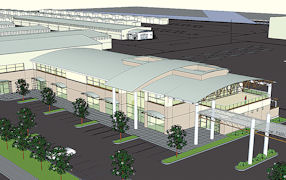A change in management at Pacific Aviation Development LLC has put the construction of a dedicated area for propeller aircraft at Van Nuys Airport back on track. The $27.5 million Park at Van Nuys project has been in the works since at least 2008, to be built on 30 acres in the northwest corner of the airfield once used by the Air National Guard. The multi-phase project will consolidate in a single location all the piston aircraft based at Van Nuys, plus create office and meeting space, an observation deck and a restaurant. Work has started on pouring cement pads for hangars and building trenches for water and electrical service, said Neil Sherman, one of the managers of Pacific Aviation. “We finally have things going after five years of back and forth,” Sherman said. T-hangars that can accommodate a single piston plane will be ready for occupancy by early summer. Construction will then begin on two larger hangars with an anticipated move in time for winter. Sherman and Eric Steinhauer have long been silent partners in Pacific Aviation but have now taken a public role to get the project moving. The pair replaces Steve Argubright as the lead coordinator of the development, who now only has a minority stake in Pacific Aviation. Pacific has developed 900,000 square feet of buildings at general aviation airports in California and Arizona. Sherman is the owner of Industrial Metal Supply, a long-time Sun Valley metal products supplier started by his father, Norman. Steinhauer is president of Industrial Metal. Having Sherman and Steinhauer in charge makes the most sense to get the prop park finished, said Eliot Sanders, a private pilot and president of the Van Nuys Airport Citizens Advisory Council. “They have a lot of skin in the game and want to have the benefit of being the developers,” Sanders said. While lacking the glamour of the Lear jets and Gulfstreams that fly in and out of Van Nuys, piston aircraft have long played a vital role at the airport. Pilots get their start behind the controls of a propeller aircraft. Propeller planes have been scattered around the airport in hangars, t-hangars and tie-down spaces. The Park at Van Nuys will put the aircraft in a single location. Timing of the project during the recession, however, proved to be a major hold up. Financing the project had been difficult during the time when Argubright had been heading it up, with first one and then a second investor backing out. “A lot of opportunity was missed because of the financing issues,” Sanders said. The Los Angeles Board of Airport Commissioners and the Los Angeles City Council approved a lease with Pacific Aviation in 2011. For Sherman, who has spent his career in the family metals business, getting into real estate development is something new. “It will be a wonderful project that we as developers will be proud of and the Valley and the aircraft community as a whole will be proud of,” Sherman said. Aerospace Clusters A bill is making its way through the California State Senate to give special tax breaks and streamlined regulations to aerospace hubs around the state. The legislation, sponsored by Sen. Steve Knight, a Republican from the aerospace-rich Antelope Valley, is currently being worked out in detail with the Governor’s Office of Business and Economic Development. The California Aerospace Innovation Hub Act would create geographically based aerospace hubs around existing aerospace manufacturing clusters, such as in Palmdale, the Santa Clarita Valley and the South Bay, Knight said. The legislation would provide tax credits to companies hiring new employees and bringing in new aircraft production and modification deals. “This addresses an industry that helped build California and is leaving in droves,” Knight said. “We want to give them an advantage for being in California.” Stock Support Investment research firm Zacks is bullish on Wesco Aircraft Holdings Inc., a Valencia company providing supply chain services and aircraft parts to the aerospace industry. The Chicago-based company upgraded Wesco shares to “outperform” from “neutral” earlier this month. And given the strength of the commercial and defense aerospace industry, the research firm forecasts a strong demand for Wesco’s services. Aircraft manufacturers will be looking to improve their supply chains to make their operations more efficient and get more planes off assembly lines and into service, Zachs reported on March 18. “This trend looks to bode well for (Wesco), as the company is an expert in this field and it is already entrenched with some of the segment’s biggest firms,” the report noted. In March, four analysts had rated Wesco as a “strong buy,” two as “buy,” and seven as “hold,” according to Thomson/First Call, a division of Thomson Reuters. Wesco had been a privately held company until it was taken public by Carlyle Group in a July 2011 IPO that raised $315 million. The Washington, D.C. private equity firm bought a majority stake of Wesco in 2006. Since then, Carlyle has reduced its stake to less than a third of outstanding shares but remains the largest single shareholder. Shares in Wesco have hovered in the $21 to $22 range for March, closing on March 19 at $21.19. Staff Reporter Mark R. Madler can be reached at (818) 316-3126 or [email protected].
